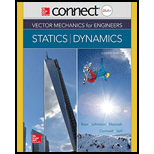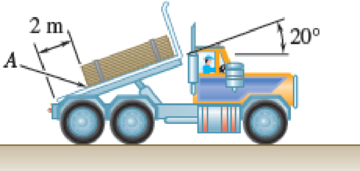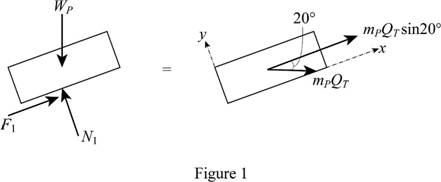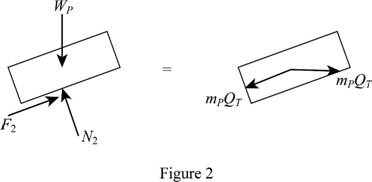
Concept explainers
To unload a bound stack of plywood from a truck, the driver first tilts the bed of the truck and then accelerates from rest. Knowing that the coefficients of friction between the bottom sheet of plywood and the bed are μs = 0.40 and μk = 0.30, determine (a) the smallest acceleration of the truck which will cause the stack of plywood to slide, (b) the acceleration of the truck which causes corner A of the stack to reach the end of the bed in 0.9 s.
Fig. P12.22

(a)
Find the smallest acceleration of the truck which will cause the stack of plywood to slide.
Answer to Problem 12.22P
The smallest acceleration of the truck which will cause the stack of plywood to slide is
Explanation of Solution
Given information:
The coefficients of static friction
The coefficients of static friction
The tilting angle
The relative distance of plywood with respect to truck
Calculation:
Write the equation of Weight of plywood
Here,
Sketch the free body diagram and kinetic diagram of plywood as shown in Figure (1).

Refer Figure (1).
Apply the Newton’s law of equation along y-axis.
Substitute
Write the equation of friction force
Here,
Substitute 0.40 for
Substitute
Apply the Newton’s law of equation along x-axis.
Substitute
Find the smallest acceleration of the truck which will cause the stack of plywood to slide.
Equate Equation (1) and (2).
Substitute
Thus, the smallest acceleration of the truck which will cause the stack of plywood to slide is
(b)
Find the acceleration of the truck which causes corner A of the stack to reach the end of the bed in 0.9 s.
Answer to Problem 12.22P
The acceleration of the truck which causes corner A of the stack to reach the end of the bed in 0.9 s is
Explanation of Solution
Calculation:
The velocity of plywood relative to truck is zero.
Find the acceleration of the plywood relative to the truck
Here,
Substitute 0 for
Sketch the free body diagram and kinetic diagram of truck as shown in Figure (2).

Refer Figure (2).
Apply the Newton’s law of equation along y-axis.
Substitute
Here,
Apply the Newton’s law of equation along x-axis.
Substitute
Here,
Write the equation of frictional force on truck:
Substitute 0.30 for
Find the acceleration of the truck
Equate Equation (4) and (5),
Substitute
Thus, the acceleration of the truck which causes corner A of the stack to reach the end of the bed in 0.9 s is
Want to see more full solutions like this?
Chapter 12 Solutions
Connect 2 Semester Access Card for Vector Mechanics for Engineers: Statics and Dynamics
Additional Engineering Textbook Solutions
Manufacturing Engineering & Technology
Vector Mechanics for Engineers: Statics, 11th Edition
Engineering Mechanics: Dynamics (14th Edition)
Applied Fluid Mechanics (7th Edition)
Vector Mechanics for Engineers: Statics
Introduction To Finite Element Analysis And Design
- A truck is traveling down a road with a 4-percent grade at a speed of 60 mi/h when its brakes are applied to slow it down to 20 mi/h. An antiskid braking system limits the braking force to a value at which the wheels of the truck are just about to slide. Knowing that the coefficient of static friction between the road and the wheels is 0.60, determine the shortest time needed for the truck to slow down.arrow_forwardIn the braking test of a sports car its velocity is reduced from 70 mi/h to zero in a distance of 170 ft with slipping impending. Knowing that the coefficient of kinetic friction is 80 percent of the coefficient of static friction, determine (a) the coefficient of static friction, (b) the stopping distance for the same initial velocity if the car skids. Ignore air resistance and rolling resistance.arrow_forwardA turntable A is built into a stage for use in a theatrical production. It is observed during a rehearsal that a trunk B starts to slide on the turntable 10 s after the turntable begins to rotate. Knowing that the trunk undergoes a constant tangential acceleration of 0.24 m/s2 , determine the coefficient of static friction between the trunk and the turntable.arrow_forward
- A car is traveling at 100 km/h along a straight, level road when its brakes become locked. Determine the stopping distance of the car knowing that the coefficient of kinetic friction between the tires and the road is 0.65.arrow_forwardThe carnival ride from Prob 12.51 is modified so that the 80-kg riders can move up and down the inclined wall as the speed of the ride increases. Knowing that the coefficient of static friction between the wall and the platform is 0.2, determine the range of values of the constant speed v0 for which the platform will remain at h = 1.5 m.Reference to Problem 12.51:arrow_forwardBaggage on the floor of the baggage car of a high-speed train is not prevented from moving other than by friction. The train is traveling down a 5-percent grade when it decreases its speed at a constant rate from 120 mi/h to 60 mi/h in a time interval of 12 s. Determine the smallest allowable value of the coefficient of static friction between a trunk and the floor of the baggage car if the trunk is not to slide.arrow_forward
- Three packages each of weight m = 9 kg A, B, and C are placed on a conveyor belt that is at rest. Between the belt and both packages A and C, the coefficients of friction are Ms = 0.30 and Mk = 0.20; between package B and the belt, the coefficients are Ms = 0.10 and Mk = 0.08. The packages are placed on the belt so that they are in contact with each other and at rest. Determine which, if any, of the packages will move and the friction force acting on each package. The frictional force acting on A is N The frictional force acting on B is N The frictional force acting on C is N Note: please show correct step by step working out. And double check final answers. Also for frictional force A, B & C show their directions as well. Thanks!arrow_forwardA rope having a weight per unit length of 0.4 lb/ft is wound 2 1/2 Times around a horizontal rod. Knowing that the coefficient of static friction between the rope and the rod is 0.30, determine the minimum length x of rope that should be left hanging if a 100-lb load is to be supported.arrow_forwardThe parallel-link mechanism ABCD is used to transport a component I between manufacturing processes at stations E,F, and G by picking it up at a station when 0 = 0 and depositing it at the next station when 0= 180°. Knowing that member BC remains horizontal throughout its motion and that links AB and CD rotate at a constant rate in a vertical plane in such a way that VB = 2.2 ft/s, determine (a) the minimum value of the coefficient of static friction between the component and BC if the component is not to slide on BC while being transferred, (b) the values of 0 for which sliding is impending.arrow_forward
- A small 250-g collar C can slide on a semicircular rod which is made to rotate about the vertical AB at a constant rate of 7.5 rad/s. Knowing that the coefficients of friction are μs = 0.25 and μk = 0.20, indicate whether the collar will slide on the rod if it is released in the position corresponding to (a) 0= 75°, (b) 0 = 40°. Also, determine the magnitude and direction of the friction force exerted on the collar immediately after release.arrow_forwardA crash test is performed between an SUV A and a 2500-lb compact car B. The compact car is stationary before the impact and has its brakes applied. A transducer measures the force during the impact, and the force P varies as shown. Knowing that the coefficients of friction between the tires and the road are μs= 0.9 and μs = 0.7, determine (a) the time at which the compact car will start moving, (b) the maximum speed of the car, (c) the time at which the car will come to a stop.arrow_forwardIn order to determine the weight of a freight train of 40 identical boxcars, an engineer attaches a dynamometer between the train and the locomotive. The train starts from rest, travels over a straight, level track, and reaches a speed of 30 mi/h after three minutes. During this time interval, the average reading of the dynamometer is 120 tons. Knowing that the effective coefficient of friction in the system is 0.03 and air resistance is negligible, determine (a) the weight of the train (in tons), (b) the coupling force between boxcars A and B.arrow_forward
 Elements Of ElectromagneticsMechanical EngineeringISBN:9780190698614Author:Sadiku, Matthew N. O.Publisher:Oxford University Press
Elements Of ElectromagneticsMechanical EngineeringISBN:9780190698614Author:Sadiku, Matthew N. O.Publisher:Oxford University Press Mechanics of Materials (10th Edition)Mechanical EngineeringISBN:9780134319650Author:Russell C. HibbelerPublisher:PEARSON
Mechanics of Materials (10th Edition)Mechanical EngineeringISBN:9780134319650Author:Russell C. HibbelerPublisher:PEARSON Thermodynamics: An Engineering ApproachMechanical EngineeringISBN:9781259822674Author:Yunus A. Cengel Dr., Michael A. BolesPublisher:McGraw-Hill Education
Thermodynamics: An Engineering ApproachMechanical EngineeringISBN:9781259822674Author:Yunus A. Cengel Dr., Michael A. BolesPublisher:McGraw-Hill Education Control Systems EngineeringMechanical EngineeringISBN:9781118170519Author:Norman S. NisePublisher:WILEY
Control Systems EngineeringMechanical EngineeringISBN:9781118170519Author:Norman S. NisePublisher:WILEY Mechanics of Materials (MindTap Course List)Mechanical EngineeringISBN:9781337093347Author:Barry J. Goodno, James M. GerePublisher:Cengage Learning
Mechanics of Materials (MindTap Course List)Mechanical EngineeringISBN:9781337093347Author:Barry J. Goodno, James M. GerePublisher:Cengage Learning Engineering Mechanics: StaticsMechanical EngineeringISBN:9781118807330Author:James L. Meriam, L. G. Kraige, J. N. BoltonPublisher:WILEY
Engineering Mechanics: StaticsMechanical EngineeringISBN:9781118807330Author:James L. Meriam, L. G. Kraige, J. N. BoltonPublisher:WILEY





